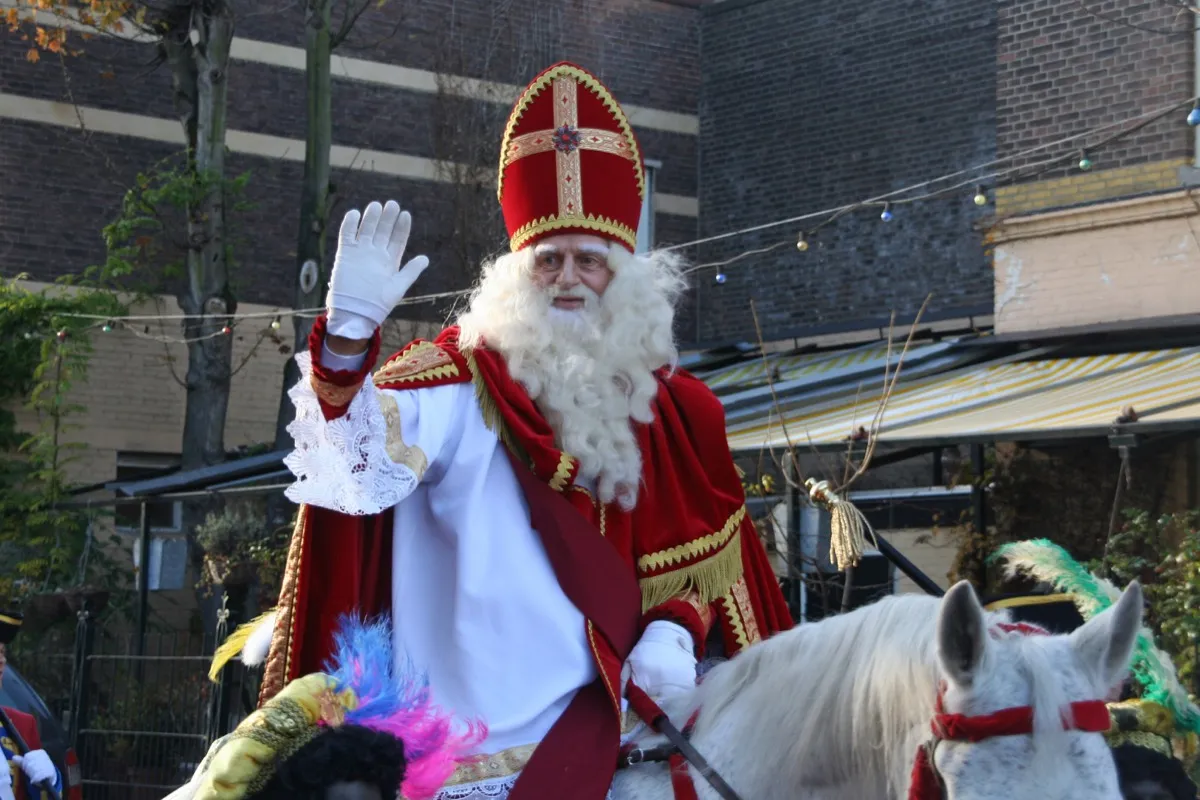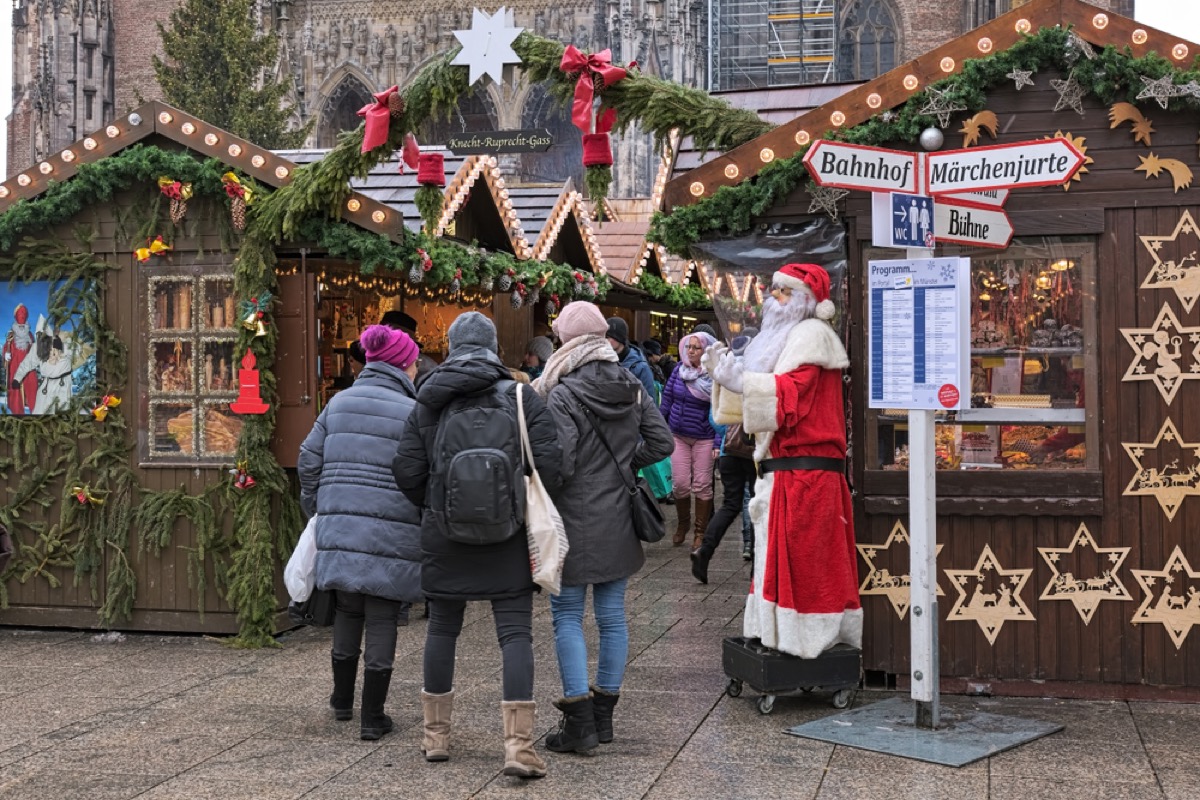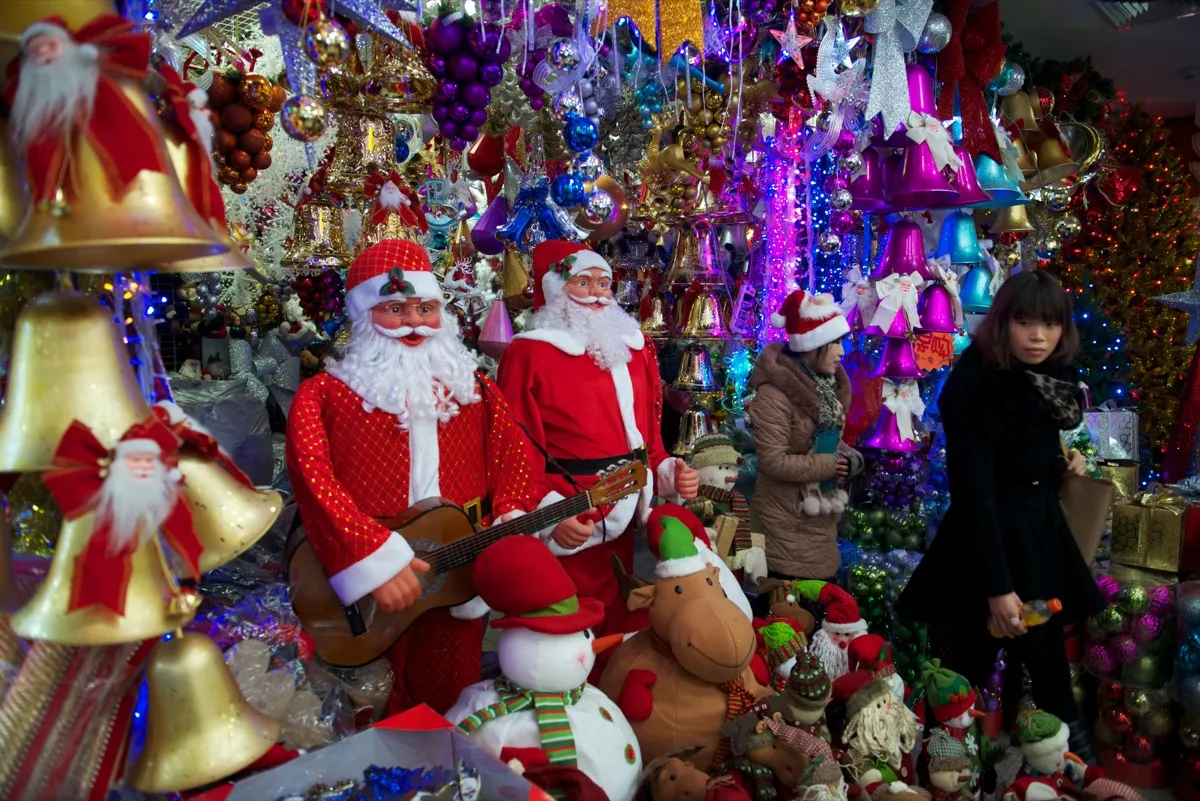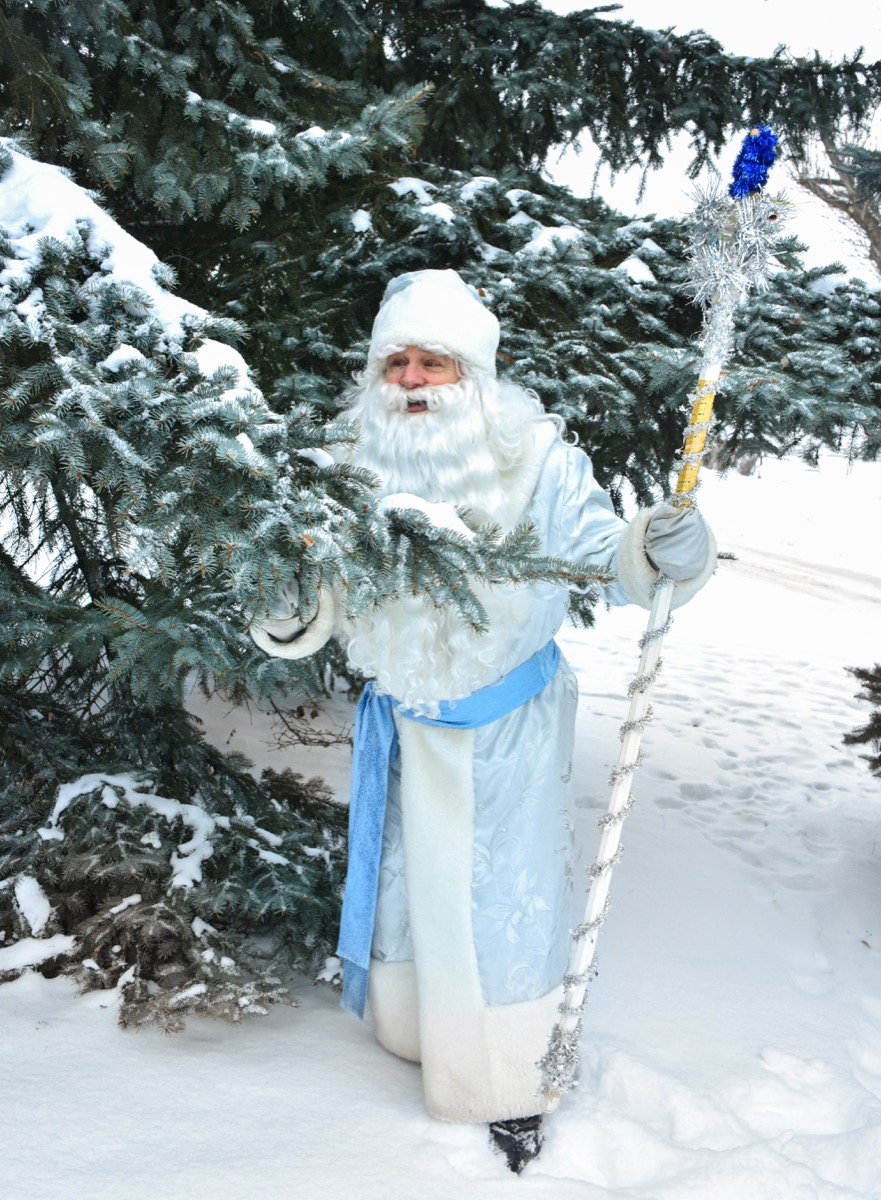13 Different Names for Santa Claus Around the World

One could argue that the most recognizable figure in America isn’t a famous actor, pop star, or athlete, but rather a timeless Christmas legend. That’s right, we’re talking about Santa Claus, a magical man whose name is as well known as his countenance—and the long white beard that covers it. And when you add in the red suit, the sack of presents slung over his shoulder, and the fact that his preferred mode of transportation is a sleigh powered by flying reindeer, it’s clear that Santa is utterly unmistakable. But though he may look similar around the world—with certain exceptions, of course—in other countries, he answers to some very different names. You likely know a few of his aliases already, like Saint Nick and Kris Kringle, but there are so many more. So, join us on our journey to learn 13 different names for Santa Claus around the world!
1
The Netherlands: Sinterklaas

The Dutch name for Santa—Sinterklaas—sort of sounds familiar, right? That because it’s where we got the name Santa Claus from in the first place. Since the 11th century, the Netherlands has been celebrating Saint Nicholas, or Sinterklass in Dutch, a 4th-century bishop who was the patron saint of children and sailors. And when Dutch settlers came to the United States, they brought their customs with them—including the story of Saint Nick, who is said to have arrived by boat from Spain every year on Dec. 5 to leave treats for Dutch children in their shoes. In America, Sinterklaas became Santa Claus.
And funnily enough, our Americanized version of the character eventually traveled back to Holland under the name Kerstman, or “Christmas man,” which means the children of The Netherlands now have two gift-giving visitors to look forward to every year!
2
Germany: Christkind

The name Christkind may also ring a distant bell to you. Perhaps you’ve heard of the Nuremberg Christkindlesmarkt, a famous holiday market in Southern Germany. Or maybe it’s because it sounds like Kris Kringle, which is where the latter name comes from. The same way Americans turned Sinterklaas into Santa Claus, they turned the German name Christkind into Kris Kringle. Like the Dutch, Germans had long associated Christmas with Saint Nicholas.
In the 15th century, however, Protestant reformer Martin Luther decided he wanted Christmas to be more about Jesus Christ and less about Catholic saints. He therefore established a new narrative in which children received Christmas gifts from the baby Jesus—the Christkind, which translates literally to “the Christ child.” Because people had a hard time imagining a baby traveling around leaving gifts, Christkind eventually came to represent an angelic girl who possessed what Christians believed to be Christ-like qualities. To this day, people in parts of southern Germany and its surrounding regions—including Austria and parts of Switzerland—still receive gifts from Christkind. But that’s not the only name Santa is known by in Deutschland.
3
Germany: Weihnachtsmann

In some parts of Germany, Santa Claus is more commonly referred to as Weihnachtsmann, or “the Christmas man.” Like Christkind, Weihnachtsmann evolved as an alternative to Saint Nicholas, who was considered most closely associated with the Catholic faith. But Christkind was still a name with religious meaning, which non-religious Germans wanted to avoid, so they created a more secular figure, Weihnachtsmann, who is basically a German adaptation of Santa Claus in America.
4
England: Father Christmas

English may be the shared language of the United States and England, but we all know there are many differences in the way it’s spoken. There are also different meanings behind certain words, depending on which country you’re in. In England, for example, french fries are “chips,” elevators are “lifts,” and cookies are “biscuits.” The vocabulary divide is also evident at Christmastime, when people in the U.K. celebrate the arrival of Father Christmas, a name that is to Santa Claus what “flats” are to apartments—two different words, same meaning.
And yet, Father Christmas actually comes from a very different set of traditions. When the Germanic Saxons came to England in the 5th and 6th centuries, they personified winter in the form of a figure known as King Frost. And later, when the Vikings arrived, they brought their ideas about the Norse god Odin, considered to be father of all the gods, who had a long white beard and was known for distributing goods to people he deemed worthy. When Father Christmas was born into English lore, he was constructed using pieces of both King Frost and Odin, among other ancient figures.
5
Latin America: Papá Noel

Spain and many other Spanish-speaking countries—including Mexico, Argentina, and Peru—also have a Father Christmas, a name that in Spanish translates to Papá Noel. Despite the name being Spanish in language, however, Papá Noel is a decidedly American import, as the original holiday gift-givers in Spanish culture were the three kings (“Los Reyes Magos”). It was believed they presented gifts to baby Jesus in the manger, and in that tradition, they are said to still bring gifts to Spanish children today.
6
Latin America: Niño Jesús

Latin America is a lot like Germany: There’s a secular Santa—Papá Noel—but also a religious alternative for those of the Christian faith: Niño Jesús, or Niño Dios. Like Christkind in Germany, Niño Jesús—who is especially popular in countries like Colombia, Bolivia, and Costa Rica (pictured here)—is a personification of the baby Jesus. But while the Germans eventually made their version of young Jesus an angelic child, in Latin America, they remain committed to the original concept: a magic infant who delivers presents to good boys and girls.
7
China: Dun Che Lao Ren

Of course, Santa Claus doesn’t limit himself to the Western world. In China, for example, there’s Dun Che Lao Ren, which translates roughly to “Christmas Old Man.” Though it’s a small population, the Christians in China celebrate Christmas Day, which they call Sheng Dan Jieh, meaning “Holy Birth Festival.” Children hang stockings in hopes of receiving gifts from Dun Che Lao Ren, who’s also known as Lan Khoong-Khoong, which translates to “Nice Old Father.”
8
Japan: Hoteiosho and Santa Kurohsu

Japan has not one, but two Santa Clauses. The first, Santa Kurohsu, is a Japanese interpretation of the American Santa. Thanks to a 1970s marketing campaign that has forever joined Christmas with KFC in the Japanese consciousness, he is sometimes confused with fried chicken icon Colonel Sanders. (Yes, really.)
The second, Hoteiosho, is a gift-giving Buddhist monk who comes on New Year’s Eve, which is more like Christmas in Japan than actual Christmas. He’s just as round as Santa and just as jolly, but he has one thing Santa doesn’t: Eyes in the back of his head that allow him to see when Japanese children are misbehaving.
9
Russia: Ded Moroz

In Russia, Santa goes by the name Ded Moroz, which translates to “Grandfather Frost.” It’s believed he descended from Morozko, a pagan “ice demon” who froze his enemies and kidnapped children, but later morphed into the more gentle character of Ded Moroz, who’s now believed to be a kind figure who gives gifts to kids instead. But he looks and does things a tad differently than other Santas: The tall, slender figure wears blue, not red, and comes out on New Year’s Eve, not Christmas Eve. Ded Moroz also prefers to ride horses over reindeer, and instead of elves as his assistants, he has his granddaughter, an Elsa-esque snow maiden named Snegurochka.
10
Norway: Julenissen

In Norway, Saint Nick looks more like one of Santa’s elves than Santa Claus himself. That’s because the Norwegian Santa, called Julenissen, is a “nisse”—a mischievous gnome with a long beard and a red hat, who is responsible for protecting superstitious farmers and their farmsteads in Scandinavian folklore. “Jul” (think “Yule”) is the Norwegian word for Christmas, so Julenissen literally translates to “Christmas gnome.” And he not only brings gifts, but also plays Christmas pranks! A similar character exists in Sweden and Denmark, where he’s known as Jultomte and Julemand, respectively.
11
Iceland: Jólasveinar

Iceland is another county where Santa takes on the form of a gnome, but in this Nordic nation, there are 13 of them! Called Jólasveinar, which is Icelandic for “Yule Lads,” they’re a merry but mischievous band of trolls who might be compared to Snow White’s seven dwarves. Like the Disney princess’ dutiful helpers, each Yule Lad has his own distinct personality. There’s Stubby, for example, who steals food from frying pans; Window Peeper, who likes to peek in open windows; Door Slammer, who keeps people awake by slamming doors; and Sausage Swiper, who steals unguarded sausages. For the 13 days leading up to Christmas, the Yule Lads take turns visiting children, who leave their shoes on the windowsill in hopes they’ll find them filled with treasures when they wake. Good children receive candy, while naughty ones get rotting potatoes.
12
Finland: Joulupukki

Instead of a gnome, Finland has a Christmas goat, or Joulupukki. Joulupukki, it is believed, was borne out of the pagan mid-winter festival known as Yule, during which young men dressed as goats—with fur jackets, masks, and horns—would travel from house to house, terrorizing each home’s occupants while demanding food and alcohol. Known as Nuuttipukki, these young men would resort to scaring children if they didn’t get what they wanted.
When Christianity arrived in Finland during the Middle Ages, the legend of Saint Nicholas somehow collided with Nuuttipukki lore. The result was Joulupukki, who is not actually a goat, but rather a Finnish Santa Claus who travels door to door visiting children like the Nuuttipukki did, but giving them gifts instead of grief.
13
Greece: Agios Vasilios

The Greek equivalent of Santa Claus is called Agios Vasilios. As in many other countries besides the U.S., he comes on New Year’s Eve instead of Christmas Eve, delivering gifts for children to open on New Year’s Day. But his schedule isn’t the only thing that makes Agios Vasilios different from Santa in the States; his lineage is also unique.
Agios Vasilios is Greek for “Saint Basil,” who is a saint of the Greek Orthodox church, unlike Catholicism’s Saint Nicholas. According to church lore, Saint Basil began his career as a lawyer, but eventually left law in order to devote his life to the church, ultimately becoming a bishop. Upon joining the church, he gave away all of his possessions and devoted his life to the poor, for whom he developed a number of charitable projects, including a soup kitchen and the Basiliad, a shelter and clinic that is considered to be the world’s first hospital. And it’s in that tradition of helping the poor that Agios Vasilios is said to bring gifts to Greek children today!